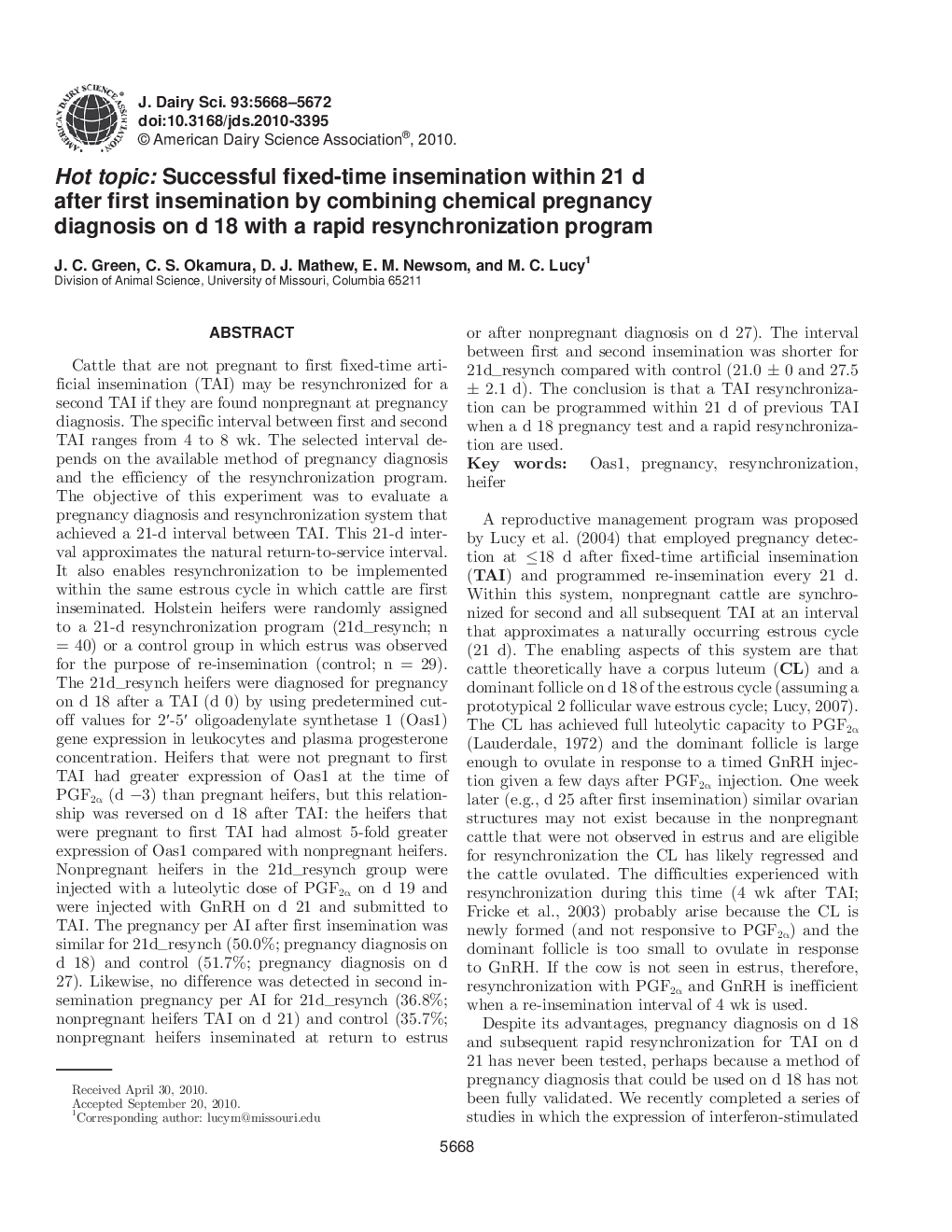| کد مقاله | کد نشریه | سال انتشار | مقاله انگلیسی | نسخه تمام متن |
|---|---|---|---|---|
| 10979166 | 1108062 | 2010 | 5 صفحه PDF | دانلود رایگان |
عنوان انگلیسی مقاله ISI
Hot topic: Successful fixed-time insemination within 21 d after first insemination by combining chemical pregnancy diagnosis on d 18 with a rapid resynchronization program
دانلود مقاله + سفارش ترجمه
دانلود مقاله ISI انگلیسی
رایگان برای ایرانیان
موضوعات مرتبط
علوم زیستی و بیوفناوری
علوم کشاورزی و بیولوژیک
علوم دامی و جانورشناسی
پیش نمایش صفحه اول مقاله

چکیده انگلیسی
Cattle that are not pregnant to first fixed-time artificial insemination (TAI) may be resynchronized for a second TAI if they are found nonpregnant at pregnancy diagnosis. The specific interval between first and second TAI ranges from 4 to 8 wk. The selected interval depends on the available method of pregnancy diagnosis and the efficiency of the resynchronization program. The objective of this experiment was to evaluate a pregnancy diagnosis and resynchronization system that achieved a 21-d interval between TAI. This 21-d interval approximates the natural return-to-service interval. It also enables resynchronization to be implemented within the same estrous cycle in which cattle are first inseminated. Holstein heifers were randomly assigned to a 21-d resynchronization program (21d_resynch; n = 40) or a control group in which estrus was observed for the purpose of re-insemination (control; n = 29). The 21d_resynch heifers were diagnosed for pregnancy on d 18 after a TAI (d 0) by using predetermined cut-off values for 2â²-5â² oligoadenylate synthetase 1 (Oas1) gene expression in leukocytes and plasma progesterone concentration. Heifers that were not pregnant to first TAI had greater expression of Oas1 at the time of PGF2α (d â3) than pregnant heifers, but this relationship was reversed on d 18 after TAI: the heifers that were pregnant to first TAI had almost 5-fold greater expression of Oas1 compared with nonpregnant heifers. Nonpregnant heifers in the 21d_resynch group were injected with a luteolytic dose of PGF2α on d 19 and were injected with GnRH on d 21 and submitted to TAI. The pregnancy per AI after first insemination was similar for 21d_resynch (50.0%; pregnancy diagnosis on d 18) and control (51.7%; pregnancy diagnosis on d 27). Likewise, no difference was detected in second insemination pregnancy per AI for 21d_resynch (36.8%; nonpregnant heifers TAI on d 21) and control (35.7%; nonpregnant heifers inseminated at return to estrus or after nonpregnant diagnosis on d 27). The interval between first and second insemination was shorter for 21d_resynch compared with control (21.0 ± 0 and 27.5 ± 2.1 d). The conclusion is that a TAI resynchronization can be programmed within 21 d of previous TAI when a d 18 pregnancy test and a rapid resynchronization are used.
ناشر
Database: Elsevier - ScienceDirect (ساینس دایرکت)
Journal: Journal of Dairy Science - Volume 93, Issue 12, December 2010, Pages 5668-5672
Journal: Journal of Dairy Science - Volume 93, Issue 12, December 2010, Pages 5668-5672
نویسندگان
J.C. Green, C.S. Okamura, D.J. Mathew, E.M. Newsom, M.C. Lucy,